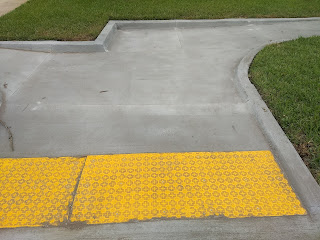Mostly, our collective frame of reference was my son's Cub Scout outing to see a wheelchair basketball team play. When I said I wasn't sure the ramps in our neighborhood were a good investment, they reminded me about the story of the team member they met who could not get into a local business where he wanted to shop. Good example, I thought, and I was happy my kids were using real evidence to make an argument. I just told them to imagine a local business clears $5,000 a month, maybe only $2,000. That business, in order to be ADA compliant for all entrances and exits, might have to spend $10,000. Add in bathrooms, and we're looking at $20,000. (I'm just spitballing here.) McDonald's, not a problem, as that restaurant might make $20,000 a week. But a local sole-proprietor business might only clear $20,000 on a down year. I just told the kids that businesses look at return on investment. If making the whole place ADA compliant will cost only $10,000, does any small business figure to make that money up with sales to people who are disabled in a year? In a decade? I think it's more complicated than just saying people who avoid ADA upgrades are bad or greedy.
The same goes for our own neighborhood, kind of. At least that was my theory. I'm not going to do a lot of research, but I've seen big projects before, and I know it's at least $100,000 to replace all the ramps in our neighborhood. Whether it's from Duval or the federal government, let's just say it's $100,000 spent on new ramps. I would not argue against ramps, actually, but the old ramps were only 14 years old. Probably perfectly ADA compliant from back then, too. I am not sure exactly how much better then new ramps are, but it has to be fairly minor. In layman's terms, the ramp has less of an incline and has a more defined yellow grip area. My assumption is that people in wheelchairs can roll down the old ramps too fast and blow right past the the old grips that were sort of cut into the cement. These are probably huge issues on some roads, especially roads with fast-driving cars or in downtown. Probably not so much in our little neighborhood.
I was also a bit dismissive of the work being done because I have not seen one person in our neighborhood using an actual wheelchair. I have seen one older lady riding a scooter (also carrying her grandkid to the pool). OK, so the people who live here in wheelchairs might not come out because of the poor ramps, but I'm not so sure. Our neighborhood is made up of about 500 housing units. Of those, about 2/3 are two-story houses or condos. Having walked the neighborhood probably 100 times in the past year, I am certain that I have not seen one ramp add-on to a house entrance. And one lady on a scooter. Conversely, the neighborhood just to the south of us has all single-story homes. If I had limited resources to use on new ramps, I would use it on that area.
The new ramps also have an unwanted side effect for my own kids. The kids have roller blades, and apparently the yellow pads are treacherous for kids on roller blades. Maybe little kids on bikes or other rolling toys, too. Probably strollers. I told my kids just to go down driveways instead, so it's not a huge deal. And I know, there's someone in a wheelchair out there yelling at the screen now because my kids are cruising around on two good legs. I'm not trying to lament my first world problems, but I am trying to understand why my neighborhood got the ramps, but I guess it stems from a 2013 lawsuit against the city, which led to $60,000,000 being spent, mostly on sidewalks. Of course, the city was supposed to be completely compliant by April of 2018, so it's likely ours is one of the last neighborhoods to get it done.
I looked up the percentages, and 14.7% of the people in Jax have a disability, defined as:
a long-lasting sensory, physical, mental, or emotional condition or conditions that make it difficult for a person to do functional or participatory activities such as seeing, hearing, walking, climbing stairs, learning, remembering, concentrating, dressing, bathing, going outside the home, or working at a job.When I dug deeper into stats, I found that about 20 million Americans are in a wheelchair, using crutches or a walker, or even a cane. Jacksonville has about 1 million people. We can assume about 50,000 (5%) people here use a wheelchair, cane, crutches, or walker. Those people are spread over 875 square miles, so about 60 people per square mile, on average. This means that in my own neighborhood, I should see about 120 people using a transportation aid of some sort. Since it's all done, there's nothing I can do about it, so I hope that those 120 people start coming out to use the new ramps. And I hope my own kids don't break an ankle on the ramps.
Thanks for reading. See more of my content:
Satisfamily - Articles about being happy as a family
Passive Ninja - Web Design in Jacksonville
McNewsy - Creative Writing
Educabana - Educational Resources
Brave New Church - Church Website Design
Voucher School - Pros and Cons of School Vouchers
Luthernet - Web Design for Lutheran Churches
Sitcom Life Lessons - What we've learned from sitcoms
Mancrush Fanclub - Why not?
Epic Folktale - Stories of the unknown
Wild West Allis - Every story ever told about one place
Educabana on Teachers Pay Teachers (mostly ELA lessons)
Real Wisconsin News - Satire from Wisconsin
Zoo Interchange Milwaukee - Community website
Chromebook Covers - Reviews and opinions
Brian Jaeger - Resume (I'm always interested)
Contact Me

